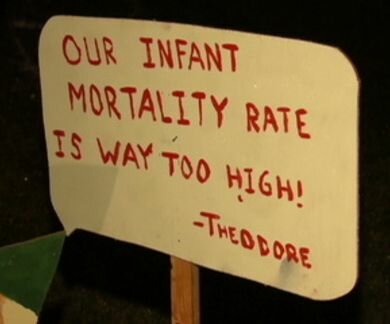Teen suicide and infant mortality in Indian Country rising
Featured — By Tim Giago (Nanwica Kciji) on March 8, 2010 at 09:18The British statesman, Benjamin Disraeli, purportedly said, “There are three kinds of lies: Lies, damned lies and statistics.”
Native Americans have been the guinea pigs of statistics since the politicians in Washington began to use arithmetic to figure out their landholdings and numbers before embarking on God’s mission of conquest and divestiture in the name of Manifest Destiny.
Since that time innumerable governmental agencies and consulting firms have joined the circle of statisticians to turn the lives of Native Americans into a virtual pie-chart of statistics. There are stats for health, housing, gaming, education and more. There are consulting firms that make their entire living by compiling statistics on Native Americans.
The statistic are compiled and filed. What happens next is anybody’s guess. If the tons of statistics compiled over the past 100 years have made any impact upon the lives of Native Americans the results are far from discernable. It seems that the only benefactors of statistics are the consulting firms, but I do not have the statistics to back up that assumption.
The only problem with basing all of the ills of society on statistics is that it entirely removes the human factor. And that is why it is nearly impossible to compile statistics that would explain the extremely high rate of teenage suicides in Indian country. The infant mortality rate on Indian reservations is so much higher than in any other place in America that it should have set off alarm bells from the Pine Ridge Reservation in South Dakota all the way to the office of Kathleen Sebelius, Secretary of Health and Human Services the titular head of the Indian Health Service.
All most of us living out here in Indian country need do when discussing the high rate of teen suicide is to read the obituary columns in any newspaper on or bordering an Indian reservation. Statistics be damned: Indian children are killing themselves and we do not seem able to stop it. Babies are stillborn or die shortly after birth and we are not able to stop it. I counted eight stillborns on the Pine Ridge Reservation in a span of two months. And the loss from teen suicides and infant deaths go on with no end in sight.
More than one Indian reservation has called emergency meetings in an effort to find a cause and a solution to these problems especially on teen suicides because they are the most obvious. The infant mortality rate, although far out of proportion with the rest of America, is still on the backburner.
It will take more than another study by statisticians to address these twin problems. The money paid to another consulting firm to compile more data should be going to an agency especially designed to address the problems.
What is it on an Indian reservation that is at the bottom of the problems? Before we can find a cure, we must find the cause. In the case of teen suicides there are a number of things that could be the cause. Trauma at home with alcoholic or gaming addicted parents. Abuse from a parent who was the victim of abuse at a missionary boarding school. Belonging to a class of have-nots. By that I mean the feelings of deprivation many teenagers get from watching television and observing all of the material things so common amongst the general population but seemingly unreachable by them. And what factor does a sense of hopelessness play in the equation? The health care givers need to start thinking like a teenage.
The infant mortality rate could be caused by pregnant teenagers ignoring the advice of health care givers and consuming alcohol or drugs while pregnant. Could there be a chemical or environmental factor on the reservation that is the culprit?
Without a doubt, and I am sure statistics would bear me out, the life expectancy on Indian reservations is dramatically lower than in the rest of America. It is almost as if the reservations are foreign countries within the borders of the USA.
But please, do not make the mistake of suggesting the Native Americans give up their homelands and join the mainstream of America because that is never going to happen. Indians have as much a right to love their reservation homelands as any American.
The Indian nations are struggling to solve the problems of teen suicide and infant mortality, but the system of care provided by the United States government leaves much to be desired. There are many Indian health care providers honestly working to make a difference, but until they know the cause of the problem, they will not find a cure, and statistics will undoubtedly be compiled to prove that point.
If America had honored the treaties it signed with the Native Nations in exchange for millions of acres of land, would the Indian people still be facing these problems?
Tags: american indian, Home News, Indian country, native americans, Talking about Race, Teen Suicides In Indian CountryAuthor: Tim Giago (Nanwica Kciji) (34 Articles)

Tim Giago, an Oglala Lakota, is the editor and publisher of Native Sun News. He is the founder and first president of the Native American Journalists Association. He was a Nieman Fellow at Harvard with the Class of 1991. He was inducted into the South Dakota Newspaper Hall of Fame in 2008. His latest book, “Children Left Behind” is available through [email protected].



 Share This
Share This Tweet This
Tweet This Digg This
Digg This Save to delicious
Save to delicious Stumble it
Stumble it





 Kanye should never have apologized to Bush
Kanye should never have apologized to Bush “Keep your #blackthoughts to yourself”: The Privilege of Twitter
“Keep your #blackthoughts to yourself”: The Privilege of Twitter ASU students rally to push passage of elusive DREAM Act
ASU students rally to push passage of elusive DREAM Act Will someone help Sen. Graham with all those black folks?
Will someone help Sen. Graham with all those black folks?







